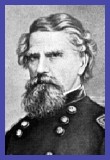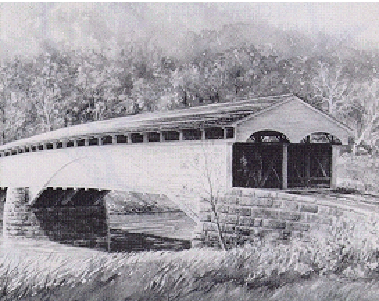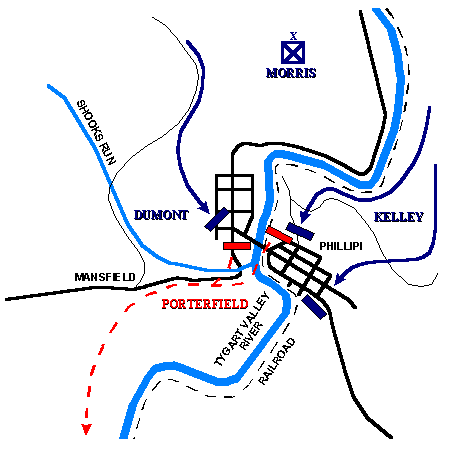| Union: Brigadier General Thomas A. Morris Colonel Ebenezer Dumont Colonel Benjamin F. Kelley | Confederate: Colonel George A. Porterfield | |
 Kelley |
"The people of Philippi were living like kings, and might have been yet, if they had behaved themselves."
-- unknown western Virginia resident, 1861.
"Soldiers! I have heard there was danger here. I have come to place myself at your head and share it with you. I fear now but one thing - that you will not find foeman worthy of your steel. I know that I can rely upon you"
-- Major General George B. McClellan, following the Battle of Philippi Bridge, 1861.
Principal Commanders
| Union: Brigadier General Thomas A. Morris Colonel Ebenezer Dumont Colonel Benjamin F. Kelley | Confederate: Colonel George A. Porterfield | |
 Kelley |
Physical Features
 |
The Philippi Covered Bridge dates back to 1852, when the General Assembly of Virginia authorized the construction of the Beverly to Fairmont Tumpike. The turnpike required construction of two bridges, one across the Tygart River at Philippi and the other across the West Fork River at Hunsakers Ferry. In Philippi, the western section of the village abuts sharply against steep slopes. The eastern section of town is in a flat, surrounded by high hills. The watercolor above shows the covered bridge from the east side of the village, toward the bluffs that bristled with Union troops the morning of 3 June 1861.
Description of the Battle
Brigadier General Thomas A. Morris desired a two-pronged attack on the town. He planned to send Colonel Ebenezer Dumont of the 7th Indiana Volunteers with about 1,500 troops and two fieldpieces down from Webster to attack on a direct route from the northwest. Meanwhile Colonel Benjamin F. Kelley of the 1st (West) Virginia volunteers would march along back roads from near Grafton south to the Turnpike and then southeast of Philippi, to surprise the Confederates in their rear with 1,900 men. Morris planed to mask these movements by encouraging the impression he was going to attack Harpers Ferry. On 2 June his forces were moving on Phillipi. Dumont had little trouble, but Kelley had to move over tortuous mountain roads. The plan was frustrated by drenching rain and unfamiliar terrain, and Kelley's forces ended up on the road north of Phillippi.
 |
Colonel George A. Porterfield held the town with approximately 1,000 men. However, his officers were so ignorant of reporting procedures that no one knew precisely what his numbers were. They awoke at dawn on 3 June to find Union troops on the hillside overlooking the village. Dumont had reached Philippi and established his cannons on the hill overlooking the covered bridge. He opened fire, which not only caught the confederates by surprise, but his own fellow commander as well. Kelley had barely reached the outskirts of the village when he heard the sounds of attack. He rushed to join in, but his troops were approaching from the north and east, leaving the turnpike clear to the southwest. Porterfield had set out very few pickets, but even those failed. Badly outnumbered and without artillery, experienced officers, or reliable munitions, Porterfield was forced to call for an immediate retreat. The green Confederate troops offered no resistance, and fled en mass toward Mansfield and then turned south under cover of Rich Mountain into Randolf County. Kelley suffered a severe wound during the battle, but recovered. Without cavalry the Union was unable to capture the Confederate troops, but were satisfied to hold the bridge and to capture a quantity of supplies and munitions.
Results
| Army | Philippi Bridge | |
|---|---|---|
| Effectives | Casualties | |
| Union | 3,400 | 4 |
| Confederate | 1,000 | 26 |
| Total | 4,400 | 30 |
Notable (Mis)Fortunes of the Principals
|
|
Return to Western Virginia |